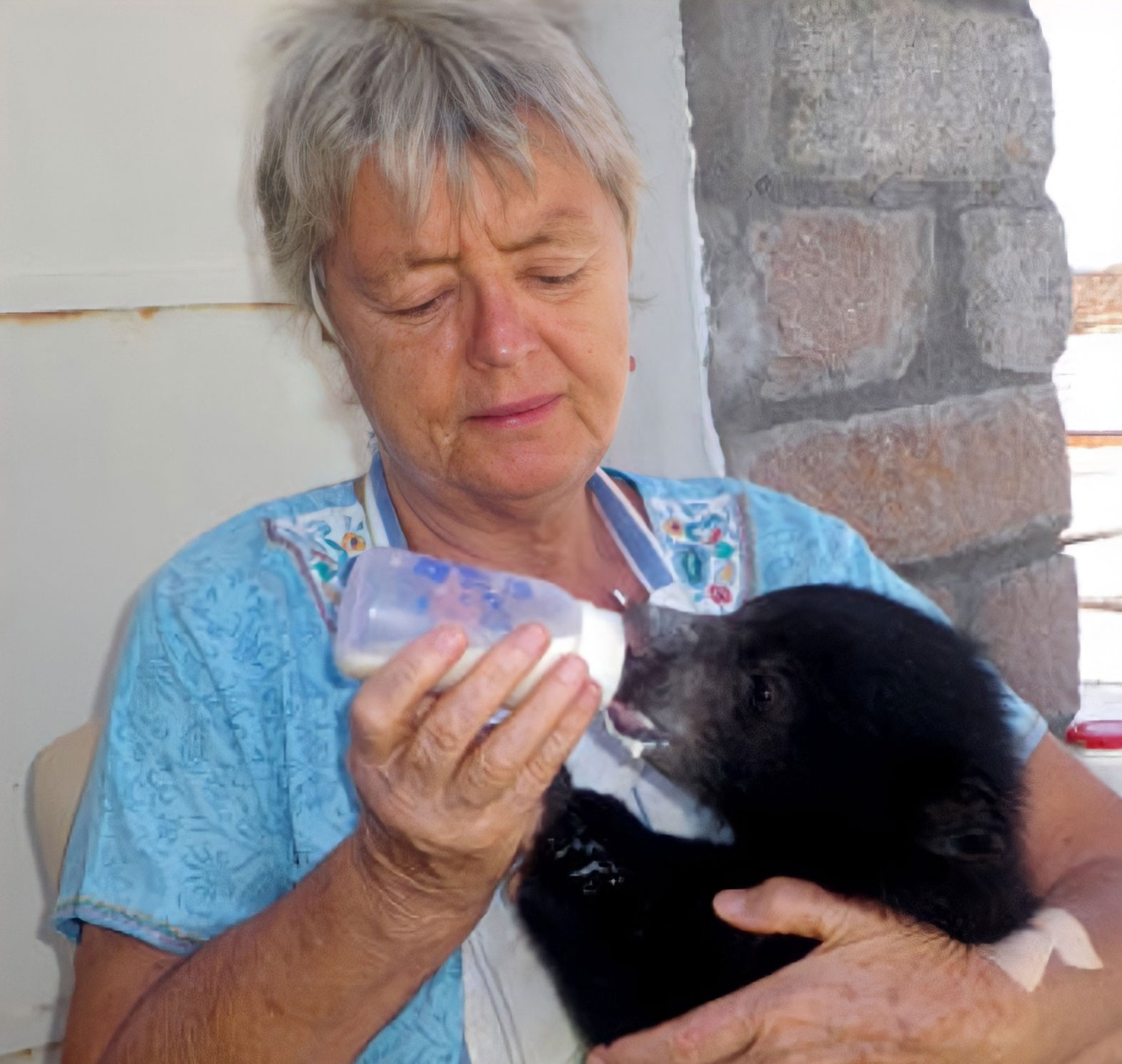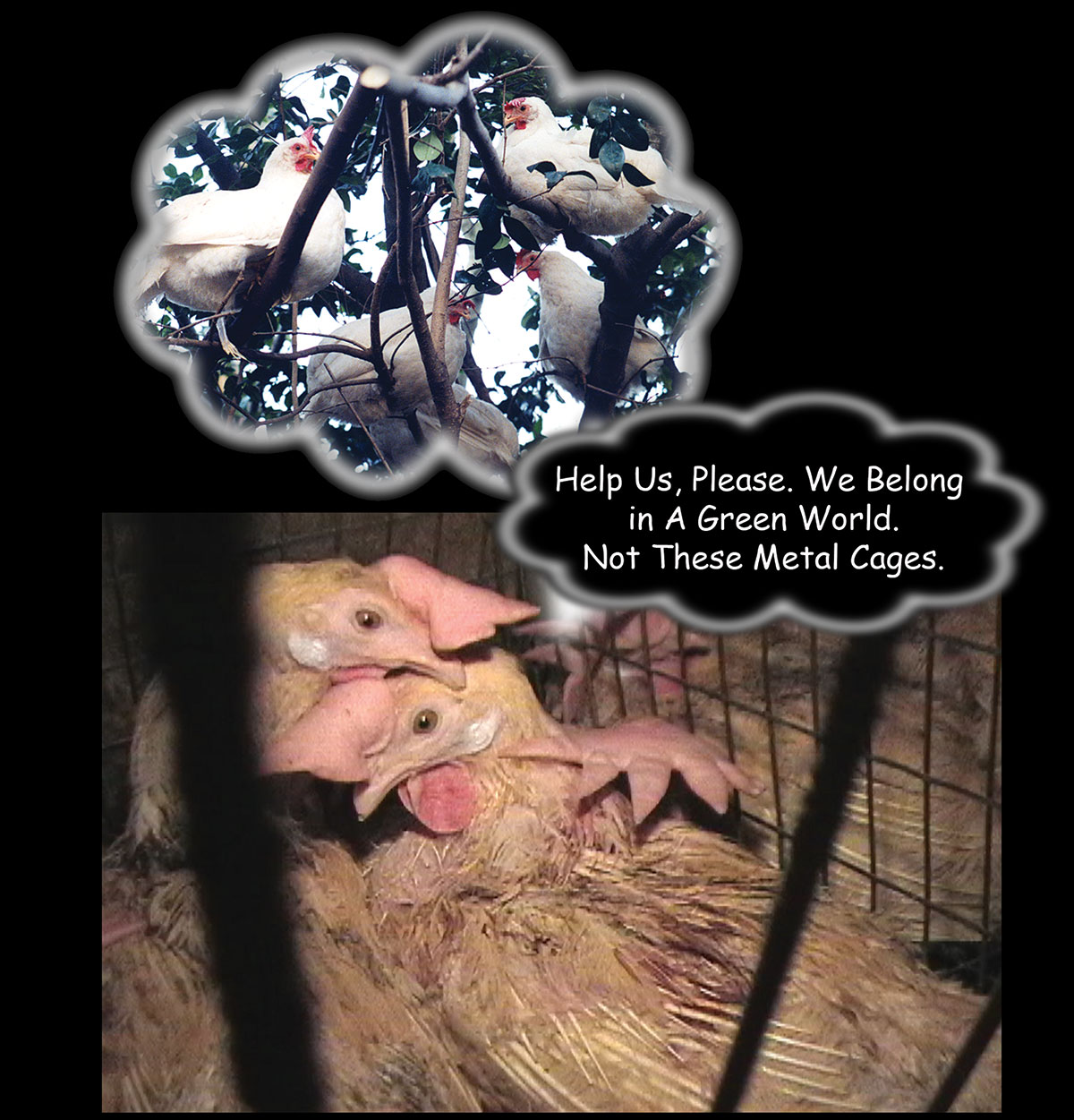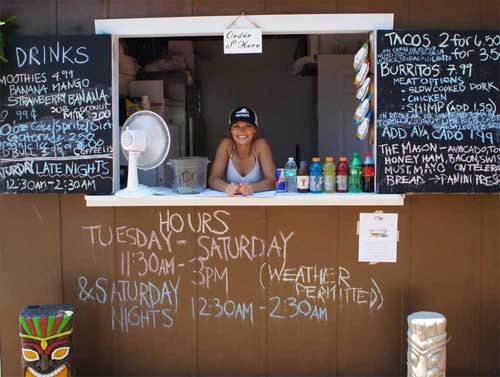This article written By Karen Davis, PhD, President of United Poultry Concerns. This article was first published October 26, 2021 on Animals 24-7.
Through the years, people have asked me how I can stand knowing what chickens and other farmed animals go through without going insane. One person, a psychotherapist, wrote to me recently about “living day and night with these horrors,”: “When I read about them,” she said, “I am filled with so much grief that I feel suicidal. I would not say anything so tiresome as ‘I can’t read about it,’ because of course I could. I just wish I could find a way not to be so filled with despair when I do. It keeps me from being more active in animal rights because I can’t imagine living with those feelings of overwhelming, helpless fury.”
What led me to think particularly about what has become known as “moral injury” was an article, On Moral Injury, in the August 2020 issue of Harper’s Magazine. Moral injury involves the guilt and shame one feels in witnessing and facilitating an atrocity – facilitating by actively contributing to it or simply by watching it and doing nothing to stop it, including the frustrated desire to end the atrocity and rescue the victims.
An example cited in Harper’s is photographers, reporters, and humanitarian workers in war zones who develop guilt over merely recording human suffering and not preventing it, even though it is not their job to intervene, and they know that. Even if some do manage to save a few victims, the guilt and vicarious trauma remain, since they can’t save everyone no matter what. Kevin Carter, who won a Pulitzer Prize for his photograph of a starving child in Sudan, wrote before killing himself in 1994, “The pain of life overrides the joy to the point that joy does not exist.”
Not surprisingly, the Harper’s article says nothing about the guilt of bearing witness or passively contributing to the suffering and death of nonhuman animals that so many of us feel, resulting in chronic depression that can become a kind of mental illness and even lead to suicide in some cases. Added to our vicarious immersion in the human-inflicted suffering and deaths of billions of helpless animals is our despairing sense that most people don’t care. As the psychotherapist quoted above went on to say, “Working with all kinds of people who don’t give a thought to suffering animals, I’m hoping to wake them up to their feelings and consequently to their awareness of the feelings of other creatures, but it is probably delusional that they will get far.”
Ethical Conflict in Veterinary Culture
Searching for professional discussions of moral injury on the Internet relating to nonhuman animals, I found one area in which it has been described: the veterinary profession. “Ethical conflict and moral distress in veterinary practice: A survey of North American veterinarians” published in 2018 considers the conflict within veterinary culture between providing futile, non-beneficial care to an animal patient at the behest of a client who wants their pet treated, even though treatment will not only be futile but deeply distressful to the patient. Though not legally or professionally bound to provide futile treatment, veterinarians struggle with their sense of obligation to their clients versus the welfare of their patients, “perhaps reflecting a cultural conflict between pets as family members and as property.”
Perhaps more to the point is what veterinarian George Bates wrote to me earlier this year:
“An article in the current Journal of the American Veterinary Medical Association [A case study of ventilation shutdown . . .] describes in excruciating detail experiments with ventilatory shutdown (or ‘VSD+’ as they are calling it nowadays) for ‘depopulating’ swine herds. In addition to an in-depth discussion of the instrumentation and technical aspects of their death chamber that make the Nazi engineers of Auschwitz seem desultory, the authors thoughtfully mention the psychic pain visited upon those humans involved in such enterprises and the possible need for mental health counseling, but nothing about the less ethereal physical suffering attendant to death by hyperthermia.”
Ethical Conflict in Animal Advocacy Culture
Cultural conflict, professional and personal, appears in the animal advocacy community, especially where farmed animals and other institutionally abused animals are concerned. At best, only a tiny fraction of these victims can be saved in rescue operations, and one’s personal agony over their unmitigated misery and the blasé attitude of society including the legal system, government, corporations, farmers, experimenters and others, are a source of unappeasable anguish and justified anger, despair, and disgust.
In From Hunting Grounds to Chicken Rights: My Story in an Eggshell I describe my own moral injury linking the soul wound of vicarious suffering to the actual, physical suffering endured by animals whose own souls are injured by the brutal and bewildering treatment they receive:
“As a college student, I was obsessed with trying to imagine what it would feel like to be in a place that was utterly inimical to one’s sense of self, against one’s will – to be forced into the abyss of total imprisonment, moral abandonment, and bewildering cruelty – a concentration camp or a death camp where everydaysuffering is overwhelmed by abnormal, human-induced suffering. For me, it is natural to try to imagine what it must be like for a nonhuman animal (like a chicken, or a turkey, or a sheep) to be forced into a human-contrived, inimical universe. For these individuals, the hell they experience is unnatural. There is nothing in the psyche of chickens to prepare them for having their beaks burned off at birth and being crammed inside a filthy building filled with toxic gases along with thousands of other suffering, terrified birds.
“How do these foraging creatures, with the leafy green world of the jungle embedded in their genes, experience entombment? How do turkeys – birds who evolved not only to run and fly, but to swim, roost high in trees at night, and roam with their mothers for five months after they hatch – how do they experience being stuffed into buildings as contaminated as cesspools? How does a grazing animal feel when forcibly herded onto a huge ship, jammed in a filthy pen, and freighted from Australia to Saudi Arabia or Iraq. How is it for a sheep to float sea-sickeningly across the Persian Gulf on the way to slaughter?”
I’m sure that these animals experience, proprioceptively within themselves, not only the violation and humiliation of their bodies but the violation and humiliation of the very essence of who they are and were meant to be through their natural evolutionary development.
Cross-Species Humiliation
The author of an article published in Harper’s Magazine on the psychology of humiliation says, “I believe the exaggerated response to humiliation is unique to our species.” The exaggerated part maybe, but the sensation of humiliation itself, the sensation of being stripped of one’s dignity, degraded, despised, defiled and treated like a thing – this experience I do not regard as a uniquely human experience. I believe the humiliation of being forced to “stand naked” in front of the Nazis noted in the article has a counterpart in other creatures, as when ethologist Konrad Lorenz observes in his article, “Animals Have Feelings,” that the hesitation of battery-caged hens “to lay their eggs in the close neighborhood of other cage inmates is just as instinctive as the hesitation of a civilized person to defecate in front of others in a similar situation.”1
Clementien Koenegras, President of Karuna Society for Animals and Nature in Puttaparthi, India, wrote to me in September this year:
“I look at the production of billions of little chicken lives, forced into existence, their bodies and children owned by the producer. The suffering, abuse and cruelty they are subjected to results in an existential trauma that prevents any possibility of expressing who they are. Inside the mass-produced little bodies there is ‘nobody home’ – their conscious, emotional and spiritual existence has been disconnected from their physical bodies by trauma. They are not being rescued. Nobody is coming for them.”

Clementien Koenegras. Photo courtesy of Animals 24-7
The Metaphysics of “Lesser Beings” – Clementien Koenegras
Clementien Koenegras, quoted above, sent me the following notes on September 12, 2021. I am sharing them here, slightly edited for publication, with Clementien’s kind permission. Her thoughts about the suffering of animals are informed, she says, by “20+ years of shelter work 24/7.” (See www.karunasociety.org.) She writes:
“’Lesser Beings’’ are life forms that have been traumatized/compromised to the point of being incapable of being the life forms they are meant to be. They have experienced an existential trauma that makes them ‘less of themselves.’ This condition has many consequences including for the life forms they are connected with.
“My personal traumatic experiences and the damage done to my ability to function as a human being have brought me very close to the lives of abused domestic and wild animals.
“I want to contribute to the understanding of the concept of ‘Lesser Beings’ by consciously going back into a deep undisclosed realm that I share with all abused life forms.
“Specific events in my own life, the destruction of my dignity, show how I became a ‘lesser being’ enabling me to be a ‘Reporter’ for those whose cries are not heard or understood.
“My forced withdrawal into myself and my following disconnection from the world have made me aware that abused animals are similarly not capable of maintaining the inner connection with their own source, nor with the world. Their trauma makes them ‘Less of Themselves,’ incapable of being the life form they are meant to be.
“It is my understanding that no cure or welfare measure will solve the problem, if the root cause of how ‘lesser beings’ are created is not acknowledged and understood.”
Is “Anybody Home” in the Psyche of a Traumatized Animal?
I am drawn to this definition of “lesser beings” in part because the term “lesser beings” has traditionally been ascribed to animals deemed inferior to other animals in a schematic hierarchy from highest (humans) to lowest. A typical example in Christianity is the notion that animals don’t have “souls.” I am drawn to this definition because it intuits and proposes, based on personal observation, logical inference, and evolutionary kinship, that other animals, like ourselves, can experience moral injury and soul wounds just as we do. Where I differ somewhat from this definition of “lesser beings” is in my belief that there is indeed “somebody home” in the traumatized psyche of a nonhuman individual. Who a morally injured animal intrinsically is and was meant to be resides, I believe, in the recesses of the psyche including the body, however overwhelmed the individual is by unnatural, unmitigated suffering.

Photos courtesy of Mercy For Animals and United Poultry Concerns
I’ve said this in writings going back to the first edition of my book Prisoned Chickens, Poisoned Eggs: An Inside Look at the Modern Poultry Industry (1996; 2009). This year I read an academic article whose author, Thomas R. Verny, bolsters my belief that every bodily cell is a repository of memory and anticipation and that no memory, be it ancestral or personal, traumatic or happy, is truly lost ‑ forgotten, suppressed or repressed perhaps, but not gone:
In Enduring memory: How can animals whose brains have been drastically remodelled still recall their kin, their traumas and their skills?, Verny concludes (unfortunately based on vivisection experiments on flatworms): “In aggregate, the evidence suggests that aspects of intelligence and consciousness traditionally attributed to the brain have another source as well. Our memories, our tastes, our life knowledge, might owe just as much to embodied cells and tissues using the same molecular mechanisms for memory as the brain itself. The mind, I conclude, is fluid and adaptable, embodied but not enskulled.”
This view accords with my conclusion to Chicken-Human Relationships: From Procrustean Genocide to Empathic Anthropomorphism:2
“Scientists cite the persistence of ‘ancestral memories’ in intensively bred, factory-farmed chickens who, though they have never personally experienced so much as the ground under their feet, have “the same drive to scratch away to get their food,” given the opportunity, as do their junglefowl relatives who spend long hours scratching away at the leaves of the forest floor to reach the tiny seeds of bamboo which they love.
“Perhaps these deeply structured memory formations, retentions, and ineffable networks of knowledge in the body and brain of a bird have something about them tantamount to what may be called ‘phantom limbic memories’ of their dismembered body parts and the experiences inscribed within those parts that make chickens, and all other animals, who they truly are. Wingless, featherless, blind and brain-damaged, entrapped in the hell of humanity, do they recall their wholeness in the phantom limbic soul of themselves? And if they do, are such memories of their essential identity, eluding the procrustean blades of annihilation, experienced as a compensation or a curse? When hens in a battery cage fall asleep, perchance to dream, how do they feel when they wake up?”
Can a Wounded Soul Heal?
The Harper’s article “On Moral Injury” that prompted this essay ends with a quote by psychiatrist Anthony Feinstein in praise of the “resilience” of the human species, which he says enables us to withstand “the evil and darkness” we project and will continue projecting into the world. “But our souls are scarred,” he says. Since human beings will continue committing atrocities as a matter of course, the issue for him is how to “heal our souls” in the face of this fact. Unlike Feinstein and various others quoted in the article, I do not see how morally, viscerally sensitive people can “heal” or be “healed” in the face of such knowledge including the relentless onslaught of the suffering we inflict on innocent, helpless individuals. Palliated perhaps, but healed?
I wonder whether Feinstein and Janine di Giovanni, the author of the Harper’s article, could empathize with those of us who suffer moral injury over the human-caused suffering of animals; I wonder if they could empathize with the traumatized animals themselves. Those of us who do animal rescue and sanctuary work know that traumatized nonhuman animals share with us a “resilience” that is almost heartbreaking to facilitate and contemplate. The only real way to “heal” ourselves is to help them recover who they truly are, and were meant to be, as best we can, through our advocacy and “managed” care for them and for ourselves.
A moral injury can empower us; it doesn’t have to be fatal.
NOTES
- This essay was originally published as “Procrustean Solutions to Animal Identity and Welfare Problems” in Critical Theory and Animal Liberation, ed. John Sanbonmatsu, Copyright 2011. Rowman & Littlefield Publishers, Inc. It is reprinted with permission in my book For The Birds: From Exploitation to Liberation: Essays on Chickens, Turkeys, and Other Domesticated Fowl, published by Lantern Books in 2019.
- Konrad Lorenz, “Animals Have Feelings,” trans. E.M. Robinson, Der Spiegel 47 (1980).





